Sustainability and the Steel City: Modernization at Pittsburgh International Airport
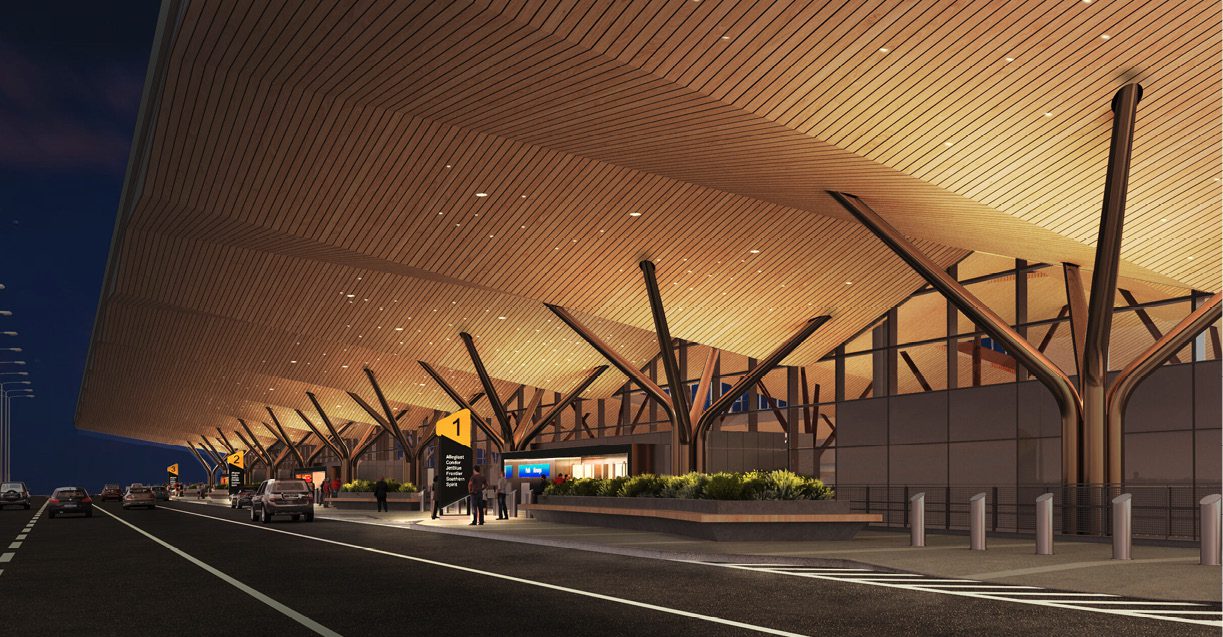
A rendering of the view future travelers will see when they approach the new terminal. (Gensler + HDR in association with luis vidal + architects)
Flying is essential for work, vacation or visiting loved ones. The industry also is necessary to ship goods overseas quickly. However, it’s not known for being environmentally friendly. One airport is seeking to change that.
Aviation contributes 3.5 percent of effective radiative forcing (which measures energy imbalance), 2.5 percent of carbon emissions and 1.9 percent of all greenhouse gas output. So there’s a strong push to reduce the carbon footprint of air travel, starting at the airport.
Pittsburgh’s Terminal Modernization
Pittsburgh International Airport’s Terminal Modernization Program is a $1.4 billion project to create a new consolidated terminal that modernizes outdated former hub facilities, better serves passengers, fuels the region’s future development, stabilizes long-term costs for airlines and evokes the essence of Pittsburgh. The new multi-modal complex will feature a new garage that nearly triples the amount of covered parking.
The PIT Terminal Modernization Program (TMP) was built upon these five principles that represent fundamental purposes driving the transformation:
1. Stabilize airline costs
2. Be Pittsburgh’s airport
3. Be environmentally sustainable
4. Enhance the experience for all customers
5. Provide value to our community
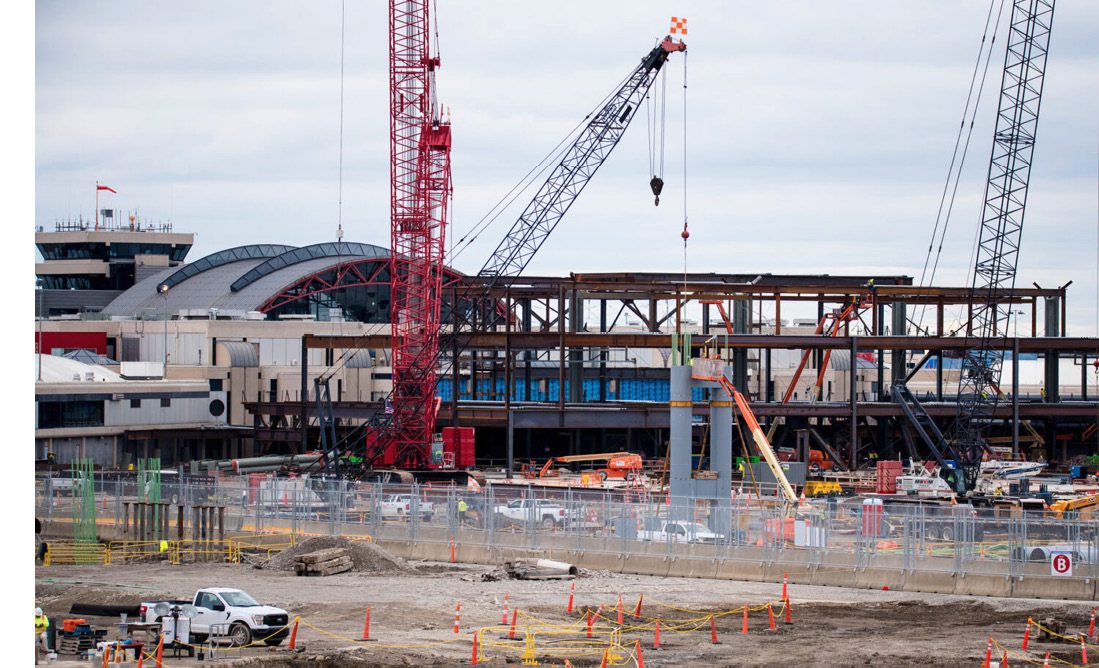
Cranes install steel beams as part of the terminal modernization program.(triblive.com)
1. Airport Modernization
The new terminal will be between the C and D airside gate concourses, eliminating the need for the people mover train. The new facility will cater to passengers flying directly to and from Pittsburgh (origin and destination traffic) as opposed to the existing facility which was largely built as a hub facility focused on connecting traffic.
2. Improved Experience
The layout should make navigating the airport quicker and easier. It will slash passengers’ time from curbside to airside in half. Aesthetic improvements will enhance everyone’s experience, and new outdoor terraces (pre- and post-security) will make it easier for travelers to relax before boarding their flight.
3. Increased Area Value
Airports raise the value of the area around them by encouraging economic growth and adding convenience for potential new residents. The terminal modernization brings more than 14,000 direct and indirect employment opportunities to the region. Currently, about 550 construction workers are onsite daily, and that number will increase to 1,000 daily workers in summer 2023.
4. Stabilized Airline Costs
Airport efficiency can impact the costs of airlines. The expansion will allow airlines to better process and load luggage as well as welcome passengers. It also lowers long-term O&M costs.
5. More Sustainable Terminal
Construction practices for the new terminal comply with Leadership in Energy and Environmental Design (LEED) Environmental Program Declaration (EPD) credit for their materials while also working to reduce emissions, water, energy and waste. Officials are targeting a minimum of LEED Silver certification for the facility.
Vendors are strongly encouraged to present products and services that comply with verified third-party certification criteria or reporting standards. The airport also urges them to source their products or materials regionally to decrease the impact on the environment and human health compared to similar vendors in other locations.
Advantus Engineers is collaborating with other teams and implementing sustainable practices such as water and energy efficiency, using sustainable materials, managing waste, employing electric transportation methods, and promoting healthy indoor environments.
Additionally, the airport is recycling and reusing construction waste, including 86,000 tons of crushed concrete for new airport roads.
The 2030 Challenge
Part of constructing the new terminal is moving the airport closer to achieving the 2030 Challenge, an environmental initiative to go carbon-neutral by that year.
The suggested plan by Architecture 2030 is to decrease 90 percent of carbon emissions by 2025 and be 100 percent carbon neutral by 2030. New buildings, renovations and additions throughout the new terminal will have energy-consumption performance standards.
A Timeline for Construction 2021
April: Officials added safe driving lanes and barricades between concourses C and D. Saw-cutting began on the ramp to remove slabs.
May: To prepare for the new terminal’s foundation, 300,000 square feet of material were removed.
June: An impact roller broke up large concrete sections to crush into smaller aggregate for reuse in new roadways.
July: Construction teams modified an underground fuel line for future use.
August and September: Team members began installation of electrical lines, construction trailers and underground utility work. Geotechnical borings for probe holes and test piles began for terminal foundation work.
October: A groundbreaking ceremony began heavy construction.
November and December: Foundation support drilling started after test borings. Mass excavation began and utility line work continued. About 85,000 tons of concrete was removed and crushed for new roads.
2022
January: Team members almost complete the auger cast piles and finish about 25 percent of the structural caissons. Approximately 400 cubic yards of concrete were used for foundation pile caps.
February: Drilling operations continued for more than half of the caissons, and auger piles were nearly completed. More than half the cubic yards of concrete for pile caps were placed, and more than 75 percent of structural steel came onto the fabrication site.
March: Installation of the first steel beams and girders. Members positioned and embedded plate girders while work was finished on terminal caissons.
April: Pile cap and grade beam installation continued. Terminal bridge foundations laid, and road modifications began.
May: Three-quarters of the pole caps installation was completed. Rebar for underground foundations and the front bridge terminal foundations were installed.
June: Crews continued to install rebar and lifted steel beams over the train tunnel.
July: More than half of the grade beam content and 25 of the 27 embedded plate girders were installed.
August and September: Vertical construction began, and crews completed foundation roadwork. Critical construction activities continued, with foundation and concrete work progressing. Workers installed decking, steel and detailing.
October: Backfill and excavation continued, and corridor walls were demolished. Bridge piers for elevated highways were installed.
November: Completed all structural slabs, and rebar installation continued.
December: Team members placed geoform, and tub girders arrived. The first elevated deck slab concrete was installed.
2023
All foundation work was completed on the site of the new terminal at the end of January. There were multiple concrete pours, and more than half of the mechanically stabilized earth walls now are in place.
Embracing Pittsburgh’s History
Pittsburgh’s industrial nickname comes from the rise of the steel industry after the Civil War. Increased demand for armament and iron boosted the local economy. Scottish immigrant Andrew Carnegie introduced the Bessemer steelmaking process, which brought him from obscurity to fame.
Carnegie began producing steel in 1875. Meanwhile, Henry Clay Frick, the grandson of whiskey distillers, made his riches operating beehive cooking ovens that could turn coal into coke—an essential steelmaking ingredient. Frick later partnered with Carnegie to form Carnegie Steel Co. and, in 1901, they merged multiple companies into the United States Steel Corp.
Before they reached their final success, however, a dispute between Carnegie Steel and the Amalgamated Association of Iron and Steel Workers put a dark cloud over the area’s steel production. It led to the Battle of Homestead, an armed conflict that killed 12 people. This event paved the way for modern labor practices and worker-protection laws.
Through the mid-1950s, Pittsburgh thrived as America’s eighth-largest city and produced half of the country’s steel. European immigration through Ellis Island led to a population increase of more than 500,000 individuals. The city’s diversity still exists in its various neighborhoods.
Things changed for Pittsburgh in the 1970s and 1980s when steel production slowed to a stop, and the city had to reinvent itself to survive. It’s now known for technology, energy, medicine, education, research, arts, sports and advanced manufacturing. Its National Football League team, the Steelers, pays tribute to its past in the steel industry. This new terminal aims to do the same. The new terminal at PIT invokes the essence of Pittsburgh through its design focused on Nature, Technology and Community—dubbed NaTeCo by the design team.
The terminal modernization progam will pay tribute to the city’s history through art and construction. Steel tree columns are a featured part of the new terminal, creating a nostalgic and stylistic design. Their brownish color is meant to invoke importance of nature in Western Pennsylvania. All of the steel in the new terminal, procured throughout the United States, is being fabricated just 10 miles away from the airport in Ambridge, Pa.
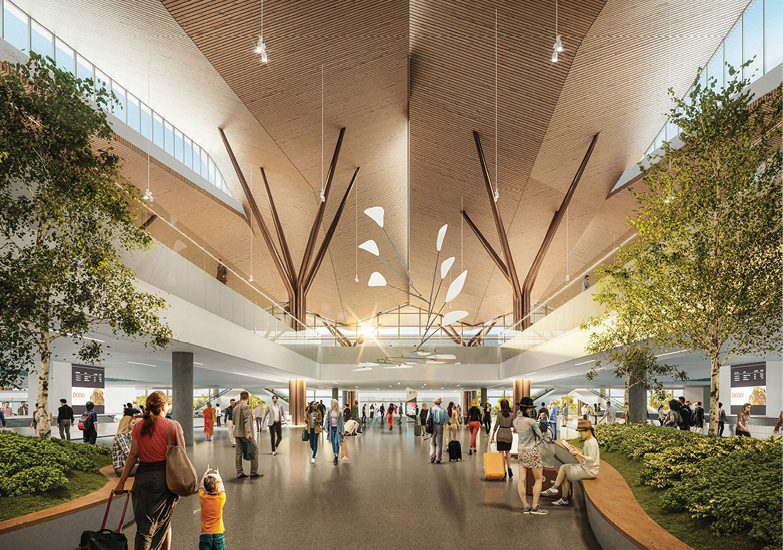
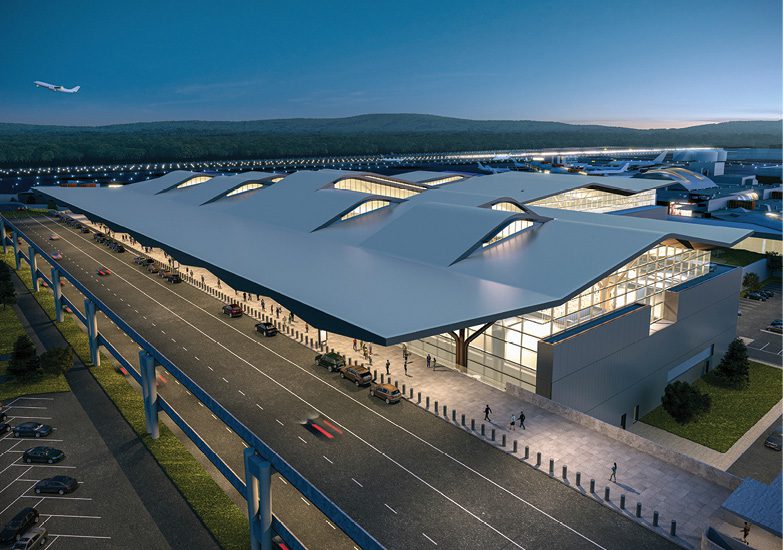
(Gensler + HDR in association with luis vidal + architects)
The Airport Authority also recruited artists Patrick Marold and Adam Kuby to create an exhibition honoring the steel industry through sculptures and other design elements. Other artisans contribute to the terminal through PIT’s Art in the Airport initiative.
Sustainability in the Steel City
Throughout the years, Pittsburgh made strides to create a healthier, more-sustainable city. From 2015-2020, the Department of City Planning released a yearly “State of Sustainability” report that examined ongoing efforts to reduce waste and minimize the use of nonrenewable resources.
Nonprofit organization Sustainable Pittsburgh advocates and educates individuals and groups through various initiatives such as recognizing corporations that make efforts toward decarbonization.
Universities in the city also are embracing measures to create a greener city. The University of Pittsburgh, Carnegie Mellon University, Carlow University and Point Park University each have their own sustainability programs to encourage research and on-campus responsibility.
The terminal modernization project is another major step toward creating a Pittsburgh that lives in harmony with its environment.
Time for an Update
Allegheny County Airport was the first airport in the region, opening in 1931, and at the time was one of the largest and most advanced terminals of its time. The Greater Pittsburgh Airport opened in 1952, becoming the region’s primary commercial airport. (Allegheny County Airport continues to operate today as a robust general aviation airport with more than 60,000 operations annually.)
That terminal existed until 1992, when officials opened the more modern Pittsburgh International Airport, built and designed as a hub for US Airways. US Airways pulled its hub status in 2004, leaving Pittsburgh with a facility built for another time and a different purpose. The airport today offers nonstop service to more than 60 nonstop destinations on 16 airlines, including international service to London Heathrow on British Airways as well service to Canada, Mexico and the Caribbean.
Both Pittsburgh International Airport and Allegheny County Airport are operated under the Allegheny County Airport Authority, which has experienced several changes through the years, with the new terminal project being the largest.
Officials announced the new terminal in 2017, but construction was put on hold in March 2020 due to the COVID-19 pandemic. The project resumed in 2021 and is now making consistent progress. The groundbreaking happened in October 2021, making it the first U.S. terminal built from the ground up after the pandemic.

Travelers will get the opportunity to enjoy fresh air and greenery while they await their flights. (Gensler + HDR in association with luis vidal + architects)
Managing Construction
ACAA selected the architecture and engineering teams of Gensler + HDR in association with luis vidal + architects to lead work on the project. This collaboration ensures international best practices are met without sacrificing local characteristics.
Gensler is headquartered in San Francisco but has multiple Pennsylvania offices and designed the PNC tower downtown. The firm also has airport experience with Incheon Airport. HDR is headquartered in Omaha, Neb., but has an office in Pittsburgh. It replaced the Greenfield Bridge and renovated the Honolulu Airport.
Luis Vidal completed terminal projects for Heathrow, Madrid-Barajas and other airports.
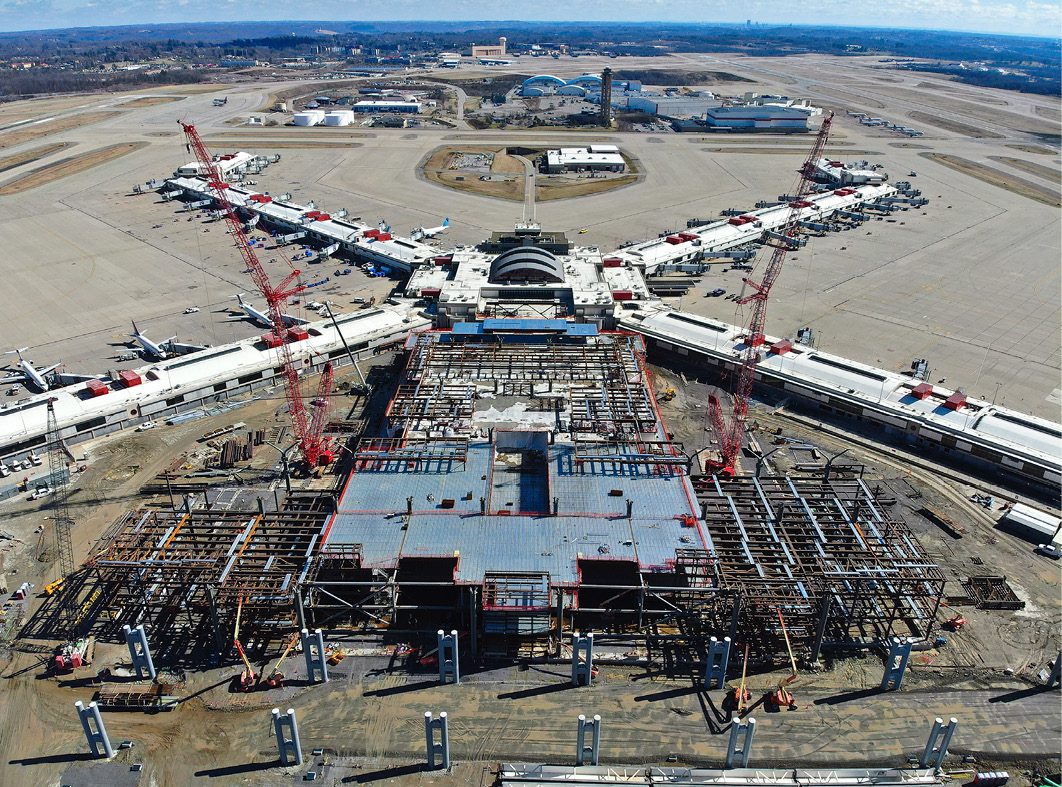
Blue Sky News/Pittsburgh International Airport
Taking in Local Concerns
The Allegheny County Airport Authority engaged the community and airlines to determine the best course of action for the terminal project. The terminal modernization has a program advisory group and a best practice group with experts in sustainability, accessibility, passenger experience, technology, health, culture and arts. These members represent constituencies, share their expertise and ensure the authority uses best practices in the new terminal design.
Feedback was gathered through community and stakeholder meetings, interviews, surveys and the feedback section of the program’s website, PITtransformed.com.
Although there are concerns with any project, Pittsburgh’s local “yinzers” are known for being open to sustainable initiatives and creating socioeconomic changes that positively impact the environment, preserving it for future generations. These efforts are known internationally, with the United Nations Foundation recognizing the city as an example of America’s growing sustainability movement.
Managing the TPM Budget
With a high cost comes the need for strict budget management, and the program management team keeps spending under control. No local tax dollars are involved, and most of the construction is funded through long-term bonds, essentially borrowing money and then paying off that debt as part of its yearly operating budget. Paying for the project comes from airport revenues, including airline fees, parking and rental fees, passenger facility charges, terminal concessions revenues, and natural gas revenue.
Natural Construction and Energy
Large windows will produce abundant natural light in the new terminal, minimizing the need for external lighting sources. Outside these windows are expansive outdoor terraces featuring local flora. Using local plants reduces the need for excess water and electricity.
Planting local trees, flowers and bushes enables visitors to learn and appreciate native plants, especially when the airport might be the only part of Pennsylvania some travelers see. They also cut carbon emissions by eliminating the need to transport outside flora.
The terrace will have chairs for passengers to relax as well as open spaces for kids and pets to run around before getting on their flights.
One of the largest changes to the terminal is the private microgrid with nearly 10,000 solar panels and five natural-gas generators. These energy sources will power the new terminal, cutting the airport’s carbon footprint and creating a more-sustainable environment. The microgrid is already up and running, powering the existing facility since June 2021. This is significant for the 2030 goal, as construction and demolition projects generate approximately 569 million tons of waste annually.
This is advantageous for passengers and airlines, providing a power source when electricity goes out as well as decreasing flight delays. In addition to being more resilient, the microgrid saves PIT more than $1 million annually in utility costs and saves more than 6 million pounds of carbon emissions annually.
Leading the Way for Sustainability
Pittsburgh International Airport’s terminal modernization project is the first post-pandemic terminal built from the ground up and holds great promise. Sustainability has always been top of mind, but the ability to continue working toward the 2030 goal after a significant delay shows a commitment to creating a more eco-friendly airport. During the construction delay, PIT designers took that time to incorporate additional public health measures into the project.
Officials hope projects can look toward PIT as an example that sustainability, economic growth, customer satisfaction and local pride can exist in the same place.
About Rose Morrison
Rose Morrison is a freelance writer with a passion for sustainable building and innovative construction technologies; email: [email protected].


